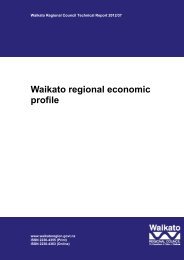Opuatia Peat Bog Management Plan - Waikato Regional Council
Opuatia Peat Bog Management Plan - Waikato Regional Council
Opuatia Peat Bog Management Plan - Waikato Regional Council
Create successful ePaper yourself
Turn your PDF publications into a flip-book with our unique Google optimized e-Paper software.
4.6 Flora<br />
Table 2: Birds recorded at WRC <strong>Peat</strong> <strong>Bog</strong> at <strong>Opuatia</strong> on 4 and 20 February 2011.<br />
Recorded in the Wetland Itself Species Notes<br />
Bowdleria punctata North Island fernbird Single bird sighted on margins of<br />
manuka scrubland.<br />
Emberiza citrinella yellowhammer 1 Conspicuous in all areas<br />
traversed.<br />
Fringilla coelebs chaffinch 1 Several heard in manuka<br />
scrubland.<br />
Gerygone igata grey warbler One heard in grey willow forest at<br />
northern end of wetland.<br />
Hirundo tahitica neoxena welcome swallow Several birds seen or heard in<br />
central and southern parts of<br />
wetland.<br />
Phasianus colchicus pheasant 1 One bird observed in planted<br />
area.<br />
Porphyrio porphyrio melanotus<br />
Recorded in Close Vicinity of<br />
the Wetland<br />
pukeko One bird observed in grey willow<br />
forest at northern end of wetland.<br />
Anas platyrhynchos mallard 1 Present on nearby pond.<br />
Branta canadensis Canada goose 1 100+ on pasture nearby.<br />
Circus approximans Australasian harrier One seen flying over.<br />
Phalacrocorax melanoleucos<br />
brevirostris<br />
little shag Two seen flying over.<br />
1 Introduced species.<br />
The most conspicuous species encountered within the wetland itself during the field<br />
survey was yellowhammer followed by welcome swallow, both of which were<br />
observed throughout. North Island fernbird (Bowdleria punctata), (classified as “At<br />
Risk-Declining” by Miskelly et al. (2008) was encountered on the margins of the wire<br />
rushland and manuka scrubland habitat during the second visit, but this was confined<br />
to one sighting. It is somewhat surprising more were not encountered given the<br />
amount of suitable habitat available.<br />
Of the birds incidentally observed within the near vicinity, Australasian harrier and<br />
mallard are the species most likely to utilise the wetland itself, but in low numbers,<br />
habitat for the latter largely being restricted to areas of open water (when available) at<br />
the northern end of the wetland.<br />
Australasian bittern (Botaurus poiciloptilus), a species classified as “Threatened-<br />
Nationally Endangered” might utilise mineralised or semi-mineralised parts of the<br />
wetland when shallow open water is present from time to time, but is very unlikely to<br />
be more than an occasional visitor. One or more pairs of spotless crake (Porzana<br />
tabuensis), (classified as “At Risk-Relict”) could potentially be resident within the<br />
northern part of the wetland where shallow water is a perennial feature of the area.<br />
One hundred and thirty-seven vascular species were recorded during the survey, and<br />
these are listed in Appendix 1. The fens were particularly rich in indigenous species,<br />
containing a wide range of sedges. No threatened species (as per de Lange et al.<br />
© 2011<br />
8<br />
Contract Report No. 2621

















